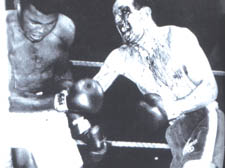|
|
 |
| |
 Muhammad Ali takes a big hit against Henry Cooper at Wembley Stadium Muhammad Ali takes a big hit against Henry Cooper at Wembley Stadium |
Man who gave boxing greats a helping hand
Some of the biggest legends of the ring might just owe some of their biggest successes to the little man who always fought their corner, writes Richard Osley
Axis Of Greatness
By Mike Winters
JR Books £14.99 order this book
IT’S an eye-wincer of a photo. Blood isn’t just streaming from Henry Cooper’s left eye, it’s gushing, splattering his nose, face and torso. You wonder how he wasn’t blinded in this bloody mess.
Muhammad Ali, for his part, isn’t looking so well either.
There aren’t many moments of weakness caught on camera but, here, as Cooper lands a painful undercut, Ali arches his stomach inwards, clearly suffering.
As much as Cooper was prone to bleeding, there are people who believe he might have beaten Ali, the Louisville Lip, or The Greatest. After all, Ali was on the deck when he was saved by the bell at the end of the round in that 1963 encounter at Wembley.
Conveniently, there was then a stoppage to patch up a split in Ali’s glove – a bit of respite. And when the two fighters reconvened Our ’Enry’s cut opened up so badly that he could not continue. Ali was advised not to leave the ring in the crown and robe he had worn as he pranced into the arena. It was sensible advice.
It was on nights like this that Ali looked around, saw Angelo Dundee in his corner, and thanked his stars.
After all it was Dundee who later admitted thumbing through a small tear in the glove to make it a split, describing it as “gamesmanship”, albeit to create a delay which was beneficial to both heavyweights.
As Mike Winters reveals in his new book, even Ali, for all his confidence and bravado, needed a bit of help along the way. And Dundee was the man.
While this is an affectionate recollection of how Ali, and after him Sugar Ray Leonard, made boxing a spectacle for the masses with their breath-taking ability and showmanship, it also unfolds as a tribute to Dundee, the coach in the corner they both relied on.
There are grisly tales here of eye-wateringly tough duels and on-the-spot medical repairs; so vivid you can almost feel the thud of the punches.
In one account, Angelo sends Ali out to fight Sonny Liston with his eyes burning and unable to see. He “danced” around the ring, avoiding blows until his eyesight returned and with it the chance to seize victory.
Before there were money-spinning title fights and contests with fantasy slogans like “Thrilla In Manilla” and the “Rumble In The Jungle”, Angelo did it for a love of the sport. In the back of a string of famous fight photos, his big-rimmed glasses peer out from the corner.
Winters insists his hero, perhaps the best known non-boxer in world boxing aside from Don King, was never really in it for the money.
When it came to Sugar Ray’s fight with Roberto Duran in 1980 – notorious because Leonard’s battered opponent left the ring apparently crying “No mas, no mas” (“No more”) – Winters reckons: “It would probably not have been hard to have talked Angelo into doing the job for nothing.”
And when Ali went from Cassius Clay to Cassius X to Muhammad Ali, Angelo, a Philly Jew, stuck by the Muslim. There was similar understanding from the coach when Ali made headline news by refusing the military draft for Vietnam in 1967, with the political stance that a disproportianate amount of black men were being sent to the controversial conflict.
There is a golden iconography attached to these boxers which seems missing sometimes in the glitz of recent Las Vegas palace fights. Nobody seems as classy as Ali when reeling out their pre-bout knockout promises.
“Whenever you see Dundee and Ali together, their genuine affection for one another is palpable,” reckons Winters, who has lived in the United States since his comedy pairing with his brother Bernie came to an end.
“Their cavalier approach to financial acquisition – in other words, accumulating money or ostentatiously displaying or hoarding wealth – was not part of their being. Muhammad gave away millions of dollars to various charities.”
But the nagging question remains: If Angelo was so good, why did he let both Sugar Ray and Ali return to the ring so many times beyond what should have been their retirement date? Did all the rope-a-dope hits that Ali took cause brain damage? Winters, clearly a boxing enthusiast to the end, believes Ali’s trembles and fight with Parkinson’s might just be down to “genetic disposition” or vulnerability to pesticides. “The jump to accuse boxing is unfair and unwarranted,” he rules.
He does, however, confess that careers were stupidly extended in the search for one more big night out in the ring: “Many people wonder why Muhammad and Sugar Ray carried on fighting so long. Surely they knew they were past their sell-by date? Maybe they didn’t know or didn’t want to believe it.
“The same personality traits that made them superstars – self-confidence, ego, courage, pride – were responsible for the sad endings to the career.”An almost Shakespearian conclusion to the lives of three dramatic sporting lives. |
 |
|
 |
 |
|
 |
|
 Muhammad Ali takes a big hit against Henry Cooper at Wembley Stadium
Muhammad Ali takes a big hit against Henry Cooper at Wembley Stadium

